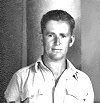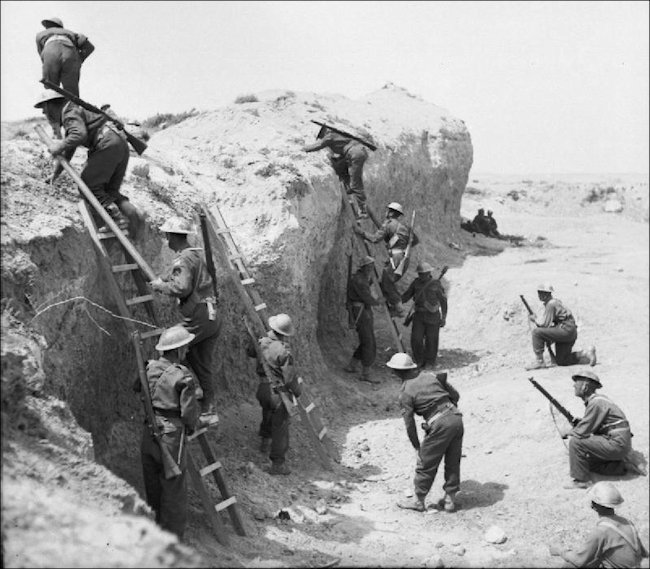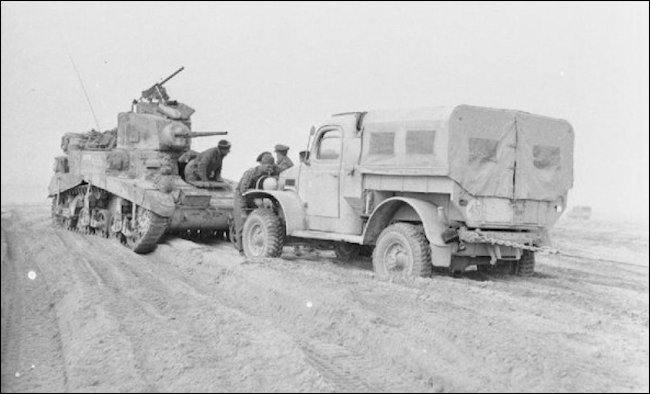2nd KRRC and the Battle or Mareth March 1943
Len Moore fought with the 2nd Battalion Kings Royal Rifle Corps 2/KRRC across the deserts of North Africa during WW2 from 1941 to 1943. His unit took part in the Battle or Mareth March 1943.

Len Moore 2nd Battalion Kings Royal Rifle Corps
What happened at the Battle or Mareth ?
This personal account was written by Major H. R. Woods, D.S.O., M.C. 2nd Battalion Kings Royal Rifle Corps
After a most exhausting spell leading to outflanking formations south of Tripoli, during which the Daily Orders comprised little beyond the simple words "push on", the 2nd Battalion KRRC was pulled out for a short rest before the impending Battle of Mareth. However, as usual, it was not long before the Higher Command again called on the 2nd Battalion KRRC to assist in the turning of the Mareth Line.
The 50th Division carried out the frontal attack, and the 2nd Battalion, now under the command of the 7th Armoured Division, were required to exert all possible pressure on the enemy's right flank in order to distract Rommel's attention into thinking we were again following our usual out-flanking tactics.

Ladders used to scale the sides of Wadi Zigzuoa on the Mareth line, 27 March 1943
Not all the enemy got clear away from the Mareth Line, for the 2nd Battalion had worked their way up into the hills on its south-western end and, after some diffcult close quarter work, their resolution was rewarded. Their advance had continued very slowly up the road from Mateur to Kreddache. Mines were everywhere and there were frequent demolitions. On the 17th March 1943 the Battalion suffered a sad loss when Lt A. T. Miller was blown up in a jeep and killed instantly.
On the 19th March 1943, two patrols of C Company led by Lts G. S. Palmer and J. J. Walters reported Kreddache clear. The Intelligence Officer, Lieut L. Asquith recorded Battalion HQ moved into a beautiful site in the centre of a small minefield. Many gunner trucks went up on. Many gunner trucks went up on mines during the afternoon, fortunately with no serious casualties. On the 20th the Battalion was withdrawn for a short rest and on the same day Maj H. R. Woods, D.S.O., M.C., arrived from the 1st Battalion to be Second-in-Command.
Once more the 2nd Battalion KRRC was launched into the mountains with the task of seizing a series of razor-backed ridges on the left flank of the Mareth position. On the night of the 24th March 1943, B Company KRRC (Maj Holmes) occupied the first of these without finding any enemy but being hampered by a sea of 'S' mines. On the following morning, they found themselves in full view of the enemy and spent a very uncomfortable day being heavily mortared, but fortunately with few casualties.
At 2300 hours, C Company passed through with the intention of attacking and occupying the next objective. A party of sappers led the way, sweeping a path, and followed by 11 and 12 Platoons (Lts Palmer and Walters). This was a lengthy and tedious job, and their difficulties were increased by having to improvise a road over the steepish wadis and hummocks to enable vehicles to pass. Half-an-hour after starting one of their vehicles went up on a mine, and the explosion brought down one round of gunfire on the gap.

A British universal Bren-Gun Carrier escorting Italian Prisoners of War 1943
The advance continued slowly with no further alarms, and at approximately four o'clock in the morning a point some 500 yards south of the feature was reached. As no noise or movement could be heard, the commander decided to send a reconnaissance party of one officer and a section up each of the left and right sides of the feature. On receiving the report 'Clear of enemy' a signal was sent back for the trucks, machine-guns and artillery 0.2. to come forward along the route which had been made and marked with tape. The hill was then occupied, with 11 Platoon on the right, 12 Platoon on the left, whilst the machine-guns and mortars remained at the bottom of the feature.
During the period 20th-25th March small company and platoon attacks were made by C Company (Major Gibbs) and A Company (Major Curtis) which eventually developed into almost major operations. The enemy holding those naturally strong positions were fully aware of their important task. They were Italians, stiffened by Germans in the rear and they put up some very tough resistance.
For three days and nights we prodded away for the weak spots alongside the Rifle Brigade battalion on our right. Mines, as usual, caused their customary unpleasant casualties, but it was altogether a new kind of fighting for us, close mountain warfare. The enemy lay concealed in caves hewn out of rock some 800 to 1,000 yards away, from where he could observe our every movement. Fortunately he seemed to possess no artillery whatsoever, and more fortunately still for us, through the combined efforts of A and C Companies, we were able to force off the ground immediately to our front, thus denying the enemy their valuable observation.
Patrols went out in small numbers by day to get information, and one such patrol unfortunately went into the bag almost under the nose of the remainder of the Company, who were watching them a mile away. They had the sad experience of watching the patrol officer and party complete being marched into captivity and unable to move themselves with the enemy snipers extremely active and accurate at very close quarters. You see, the patrol had made a long detour and had actually skillfully reached their objective in the rear of the enemy. For once the Italians were too smart for us.
At 1100 hours on 26 March 1943, a small patrol from B Company, led by Lt E. G. Pople, set out to reconnoitre the ground as far north as the road junction. This patrol was last seen moving north along track at about 1230 hours, and shortly afterwards small-arms fire was heard. Although due back at 1500 hours they did not return, and a prisoner of war subsequently confirmed that they had been captured.
At midday a small party of enemy infantry managed to crawl on their stomachs up the eastern edge of the C Company feature, aided by the difficulty of keeping watch this side, as the platoon who were looking out in that direction were in full view of the enemy strong-point on the next feature. The enemy, having concealed themselves behind a knoll on the top right-hand side of the ridge, sniped and flung hand grenades at 11 Platoon.
This meant that only sixty yards separated them from the Platoon who, hiding behind rocks and firing at anything which appeared on the skyline, managed to push them off and eventually restore our observation. Throughout the afternoon the 75-mms shelled effectively, dropping shells on top of the ridge and the whole way down the side of them to do this. In the course of these engagements our 0.2. was shelled out and two signalmen were wounded. Whenever any enemy were seen moving about, continuous sniping was kept up until they had gone to ground. When thus engaged the enemy would send up a red Very light and a heavy barrage would then come down on our positions.
It was decided that during the night C Company would be reinforced by two platoons of B Company, while A Company would occupy the enemy strong-point which was enfilading their position.

A British Stuart tank comes to the rescue of a Bedford truck which has become stuck in soft sand
End of the Battle
At first light, 28th March, it was quickly noticed that it was possible to walk about on top of 308 without drawing any fire. A Company mortared the shoulder, whereupon thirty men promptly appeared, each with a white flag bravely flying, and advanced towards our positions.
Another party of three men, bearing in their turn a vast white flag, appeared from Point 208. They started to approach our positions, at times halting uncertainly; by dint of encouraging them with a burst of small-arms fire on such occasions, they approached and surrendered. One of the three, on being reassured that he would not be shot at, went back and returned with a further 50 men.
Twenty more Italians came in from the feature. They had been there all the time but had not fired a single shot. When questioned about this they replied that they had been too tired to fire the mortars they had with them. Further Italians came in throughout the day and by 2000 hrs. the total was 151, 8 officers and 143 other ranks.
One of the latter stated that the infantry attack on the eastern slopes of Point 308 on the night 26th/ 27th March 1943 was carried out by 80 men, of whom 30 were wounded. Much equipment was found in the strong-points, including 4 mortars, 2 anti-tank guns, 1 65-mm. gun, 1 20-mm. gun, 6 machine guns, 2 trucks, 1 motor-cycle, 1 3-tonner disabled and a Quartermaster's lorry containing a large number of boots. It was expected that a full count would reveal more.
A Brief Rest
Everyone, including the Colonel, had been on the go continuously, and we badly needed, and felt we deserved, a break. This would be the first since El Alamein.
General Erskine, Commander 7th Armoured Division, came to see us, spoke to all companies and congratulated them on the important part they had played in this major battle and we got our promised rest. Major Lowe arrived to take over Second-in-Command of the Battalion (vice Major Sykes, who had been wounded near Foum Tahoune). He had rather a shock when he found Major Woods already installed in that capacity, but at once set about reorganizing B Company with his usual energy.
All were very tired and battle weary, and this was just what the Battalion needed to get into shape for the final fling at Tunis, if we were required. The Colonel sent himself on a course, thinking we would take little part in further operations. Major Curtis spent many hours experimenting enemy weapons. And with the glorious weather, surrounded by the wild flowers of the Medenine Valley, life seemed very peaceful after the hectic time we had been through
Our energetic Brigadier, J. Currie, who had just arrived from Syria, was, however, determined that the 4th Armoured Brigade should be in at the kill, and with the enemy now streaming north from Aquarit time and space were getting short. So it was perhaps not surprising when we got Ovelve hours' warning to move north, prepared to join the 7th Armoured Division and take a further part in the chase.